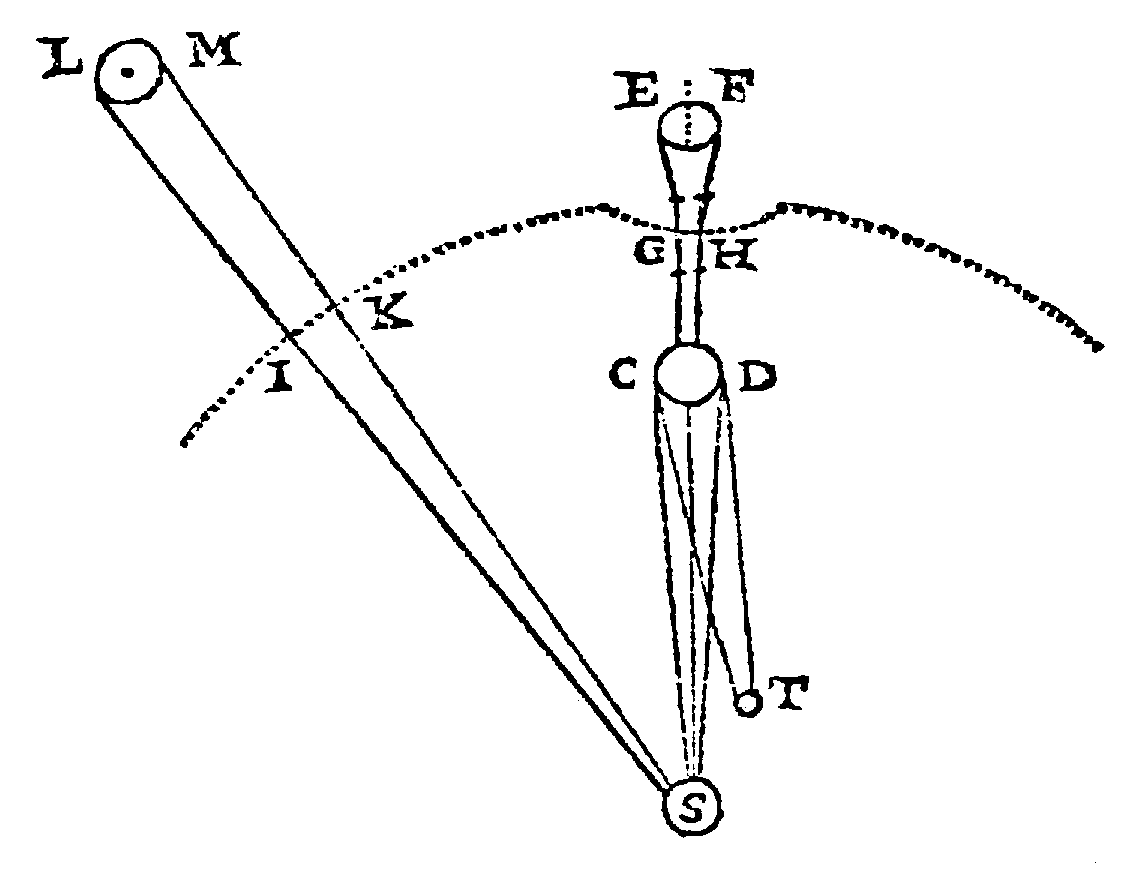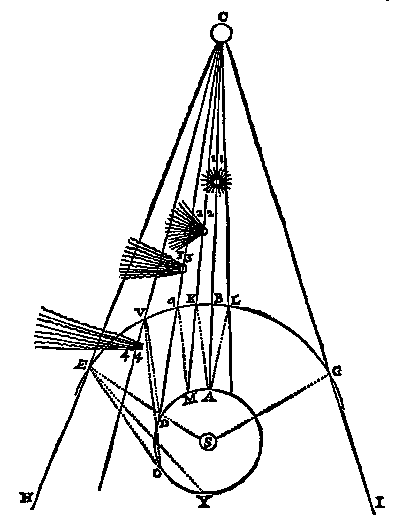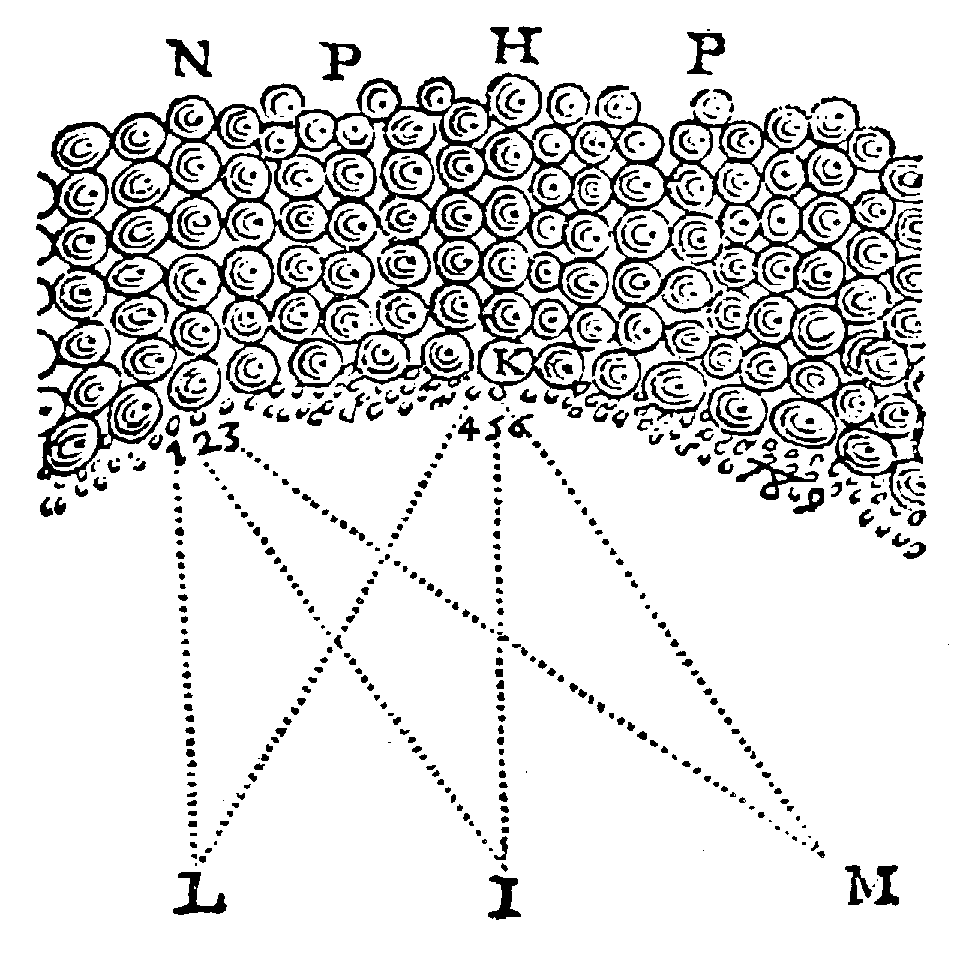Comets
8 minutes • 1517 words
The comets that are not in the sun’s territory send less rays towards the Earth as when they were in the sun’s territory.
- Consequently, such comets cannot be seen unless their size is extraordinary*.
*Superphysics note: This is why supernovae are used as standard candles for measuring the expansion of the universe
This is because most of the rays that the sun sends to them to reveal them are dissipated by the refraction that they undergo at the edge of that boundary.
For example, the comet CD receives from the sun all the rays between the lines SC and SD.
- It sends back to the earth all those between the lines
CTandDT

The comet EF receives from the same sun only the rays between the lines SGE and SHF.
- This is because those rays pass much more easily from
sunto the edgeGH(which is a part of the firmament that they cannot pass beyond) - This makes their refraction very great and very much outward.
This diverts many of them from going toward the comet EF, given first of all that this surface is curved inward toward the sun, just as you know it should curve when a comet approaches it.
But, even if it were completely flat, or even curved in the other direction, most of the rays that the sun sent out to it would not cease to be impeded by the refraction, if not from going up to it, at least from returning from there to the earth.
For example, if IK is the edge of the gravitational territory of S, the rays SIL and SKM should not bend there at all in going towards the comet LM.
But they should bend greatly in returning from the comet toward the earth, so that they can reach the earth only very feebly and in very small quantity.
This can happen when the comet is still far from the sun’s territory.
- If it were close to the sun’s territory, it would cause that territory’s edge to curve inward.
Its far distance also impedes it from receiving as many rays as when it is ready to enter the sun’s territory.
- That comet receives rays from the star at the center of the gravitational territory containing it.
- It cannot send those rays back towards the earth any more than the new moon can send back those of the sun.
Those comets possess a certain refraction of their rays.
- This is why some of them appear around the comets as a tail or a curl*.
*Translator’s Note: In the Assayer (trans. Drake in Drake and O’Malley, Controversy (see n.45), 190), Galileo describes the phenomenon as a “curl” [chioma]. Descartes’ term is chevelure, which literally means “head of hair”

Let:
Sbe the sunCbe a cometEBGbe the sphere that made up of those parts of the aethereal air that are the largest and least agitated of allDAbe the Earth’s orbit
Imagine the ray coming from C toward B passes straightaway to point A. It begins at point B to grow larger and to be divided into many other rays, which extend every which way in all directions.
Thus, each of them is that much weaker as it is carried farther away from the one in the middle, BA, which is the principal ray of all and the strongest.
Then, too, when the ray CE is at point E, it begins to grow larger and also to be divided into many others, such as EH, EY, ES.
The principal and strongest of these, however, is EH, and the feeblest is ES. In the same way, CG passes principally from G toward I, but in addition it is also carried away from S and toward all the spaces between GI and GS.
Finally, all the other rays that can be imagined between those three rays CE, CB, and CG hold more or less to the nature of each of them, according as they are more or less close.
To this I might add that they should be a bit bent toward the sun; but that is in fact not necessary for my purposes, and I often omit many things in order to render those I do explain that much simpler and easier.
When the Earth is at A, the ray BA causes men on Earth to see the body of comet C, but also the rays LA, KA, and others like them, which come to their eyes more feebly than BA, should cause to appear to them a crown or curl of light uniformly spread out in all directions around the comet (as you see at the place marked 11), at least if they are strong enough to be perceived.
They can often be strong enough coming from comets, which we suppose to be very large, but not coming from planets, or even from fixed stars, which one must imagine to be smaller.
When the earth is at M and the comet appears by means of the ray CKM, its curl should appear by means of QM and all the other rays tending toward M, so that it extends farther than before in the direction opposite to the sun, and less far or not at all toward the person looking at it, as you can see here at 22.
Thus appearing longer and longer on the side opposite the sun, to the degree that the earth is farther away from point A, it little by little loses the shape of a curl and is transformed into a long tail, which the comet trails behind it. For example, when the earth is at D, the rays QD and VD make it appear like 33.
When the earth is at O, the rays VO, EO, and others like them make it appear still longer.
Finally, when the earth is at Y, one can no longer see the comet because of the interposition of the sun.
However, the rays VY, EY, and others like them do not cease to cause its tail still to appear in the shape of a chevron or of a torch, such as here at 44.
Since the sphere EBG is not always exactly round, nor also any of the others it contains (as is easy to judge from what we have set out), those tails or torches should not always appear exactly straight, nor in fact in the same plane as the sun.

The refraction that causes all of this is of a nature very special and very different from all those commonly observed elsewhere.
Ball H is being pushed toward I.
- This causes
Hto push all those below it down toK
But K is surrounded by many other smaller balls, such as 4, 5, and 6.
- It only pushes
5towardI - It meanwhile pushes:
4towardL6toward M, and so on.
It does so in such a way that it pushes the middle one, 5, much more strongly than the others, 4, 6, and those like them which are on the sides.
In the same way, the ball N, being pushed toward L, pushes the small balls 1, 2, and 3, one toward L, the other toward I, and the other toward M.
But with this difference, that it pushes 1 the most strongly of all, and not the middle one, 2.
Moreover, the small balls 1, 2, 3, 4, etc., being thus all pushed at the same time by the other balls N, P, H, P, impede one another from being able to go in the directions L and M as easily as toward the middle, I.
Thus, if the whole space LIM were full of similar small balls, the rays of their action would be distributed there in the same manner as I have said are those of the comets within the sphere EBG.
You object that the inequality between the balls N, P, H, P and 1, 2, 3, 4, etc. is much greater than that between:
- the air-aether particles of the sphere
EBGand - those that are immediately below them toward the
sun.
I reply that one can draw no other consequence from this than that there should not take place as much refraction in the sphere EBG as in that composed by the balls 1, 2, 3, 4, etc.
However, since there is in turn some inequality between the parts of the air-aether that are immediately below this sphere EBG and those that are still lower toward the sun, this refraction increases more and more as the rays penetrate farther.
Thus, when the rays reach to the sphere of the earth DAF, the refraction can well be as great as, or even greater than, that of the action by which the small balls 1, 2, 3, 4, etc. are pushed.
The air-aether towards this sphere of the earth DAF are no less small in comparison with those toward the sphere EBG than are those balls 1, 2, 3, 4, etc. in comparison with the other balls N, P, H, P.






